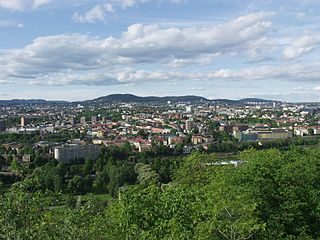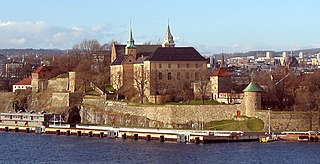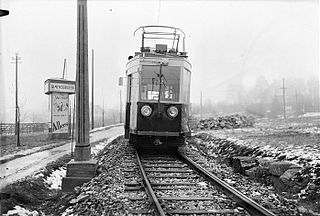
Oslo is the capital and most populous city of Norway. It constitutes both a county and a municipality. As of 23 November 2020, the municipality of Oslo had a population of 697,549, while the population of the city's greater urban area was 1,019,513, as of 4 November 2019. The metropolitan area had an estimated population of 1.71 million.

Akershus is a traditional region and current electoral district in Norway, with Oslo as its main city and traditional capital. It is named for Akershus Fortress in Oslo. From the middle ages to 1919 Akershus was a fief and main county that included most of Eastern Norway; from the 17th century to 2020 Akershus also had a more narrow meaning as a (sub) county that included most of the Greater Oslo Region. From 2020 the former county of Akershus was merged into Viken along with the former counties of Østfold and Buskerud.

Stord is a municipality in Vestland county, Norway. It is located in the traditional district of Sunnhordland. Stord is sometimes called "Norway in miniature" since it has such a variety of landscapes: coastline, fjords, forests, agricultural land, and mountain areas. The administrative centre of the municipality is the town of Leirvik, which is also the largest town in the municipality and the whole region of Sunnhordland. Leirvik was declared a town in 1997. Other population centres in the municipality include the large village of Sagvåg and the smaller villages of Litlabø and Grov.

Odda is a former municipality in the old Hordaland county, Norway. The municipality existed from 1913 until its dissolution in 2020 when it was merged into Ullensvang Municipality. It was located in southeastern Hordaland county, surrounding the southern end of the Sørfjorden. The administrative centre was the town of Odda, which was also the main commercial and economic centre of the entire Hardanger region. Other villages in the municipality included Botnen, Eitrheim, Håra, Røldal, Seljestad, Skare, and Tyssedal.

Lærdal is a municipality in Vestland county, Norway. It is located on the south side of the Sognefjorden in the traditional district of Sogn. The administrative center of the municipality is the village of Lærdalsøyri. The old Filefjell Kongevegen road passes through Lærdal on its way to Valdres and later to Oslo.

Egersund is a town in Eigersund municipality in Rogaland county, Norway. The town is located along the southwestern coast of Norway, about 75 kilometres (47 mi) south of the city of Stavanger. The town is situated along a strait which separates the mainland from the island of Eigerøya. From 1838 until 1964, the town was also an independent municipality.

Ullern is a borough of the city of Oslo, Norway.

Stovner is a borough located to the far north east of the city of Oslo, Norway. Historically, Stovner was the name of a farm in the municipal borough "Østre Aker". Østre Aker merged with Oslo in 1948, both instigated and followed by a massive expansion of the city settlement. Today's Stovner borough is constructed atop the home fields of the Stovner farm, the first record of which dates back to the 14th century, as well as on the fields of several other farms that were situated in the area covered by the borough. The bulk of the modern high-rise structures were built by Selvaag and completed in the first half of the 1970s, together with several schools, a subway line into central Oslo, and an administrative center for the borough. The last three stations of Grorudbanen — Rommen, Stovner and Vestli — are in the Stovner borough.

Vestre Aker is a borough of the city of Oslo, Norway. It has a population of 50,157 as of 2020.

Nordre Aker is a borough of the city of Oslo, Norway.

The Røa Line is a rapid transit line of the Oslo Metro, Norway, which runs from Majorstuen in Oslo to Østerås in Bærum. It serves neighborhoods such as Smestad, Hovseter, Huseby and Røa in northwestern Oslo, and Grini, Øvrevoll and Østerås in northeastern Bærum. The line is served by Line 2 of the metro, which connects to the city center via the Common Tunnel and onwards along the Furuset Line. The lowest part of the Røa Line, consisting of two stations, is shared with the Kolsås Line, and thus also served by Line 2 of the metro. The Røa Line is owned by Kollektivtransportproduksjon, and operated by Oslo T-banedrift on contract with the public transport agency Ruter.

The Furuset Line is a 5.6-kilometer (3.5 mi) long line on the Oslo Metro between Hellerud and Ellingsrudåsen in Oslo, Norway. Running mostly underground, it passes through the southern part of Groruddalen, serving neighborhoods in the boroughs of Alna and Furuset. The line is served by Line 2 of the metro with four or eight trains per hour. The line is owned by Kollektivtransportproduksjon and operated by Oslo T-banedrift on contract with Ruter using MX3000 trains.

The Sognsvann Line is a rapid transit line on the Oslo Metro of Norway. It branches from the Common Tunnel at Majorstuen and runs 6.0 kilometers (3.7 mi) to Sognsvann. After Ullevål stadion, the Ring Line branches off. The Sognsvann Line serves the northwestern and northern neighborhoods of Oslo, mostly within the borough of Nordre Aker. The line is owned and maintained by Kollektivtransportproduksjon and has nine stations. The western end of line 5 serves the entire line. Line 4 and the eastern end of line 5 serve the southern part of the line up to Ullevål stadion before branching off and continuing along the Ring Line. This gives an average five-minute headway on the southern part and an average fifteen-minute headway on the northern part of the line.
Aker is a former independent municipality in Akershus, Norway, that constitutes the vast majority of the territory of the modern city of Oslo.

The Ekeberg Line is a 6.6-kilometre (4.1 mi) long light rail line of the Oslo Tramway which runs from Gamlebyen to Ljabru in Oslo, Norway. Operated by lines 13 and 19, it serves the area of Nordstrand and the neighborhoods of Ekeberg, Jomfrubråten, Bekkelaget and Ljan. The line is operated by Oslo Sporvognsdrift using SL79 and SL95 trams on contract with Ruter. The line itself is owned by Sporveien. At Oslo Hospital, the line connects to the Bjørvika Line, which runs to the city center.
A/S Akersbanerne was a municipal owned company that operated tramways in the former Municipality of Aker in current Oslo, Norway. The company was established in 1917, and opened the suburban Østensjø Line tramway in 1926; it took over the majority ownership of Holmenkolbanen in 1933, that owned the Holmenkoll Line, Sognsvann Line and the Røa Line. Akersbanerne merged with Oslo Sporveier in 1949, following the merger of the municipalities.

The Simensbråten Line was a light rail line of Oslo Tramway between Jomfrubråten and Simensbråten in Oslo, Norway. Opening on 30 September 1931, it branched off the Ekeberg Line at Jomfrubråten and had three stops along the 1.5-kilometer (0.9 mi) route—Ekebergparken, Smedstua and Simensbråten. Operated by Ekebergbanen, the line was closed on 29 October 1967. It is the only light rail line in Oslo to have been closed.
The Norwegian Centre for Violence and Traumatic Stress Studies is a research centre in Oslo, Norway, and Norway's national research institution in violence and sexual abuse; disaster management, terrorism, armed conflicts and traumatic stress; and forced migration and refugee health research. It is interdisciplinary and employs experts mainly in psychology, psychiatry, and the social sciences. In addition to carrying out research and related activities, the institute advises the Government of Norway in its areas of expertise and has some official emergency management functions at the national level. NKVTS has 101 employees.

Oslo University Hospital is a university hospital in Oslo, Norway. With over 24,000 employees it is one of the world's largest hospitals, and the largest in Northern Europe. It is affiliated with the Faculty of Medicine of the University of Oslo and is one of the largest medical research institutions in Europe.

Gaustad Hospital is a psychiatric hospital in the neighborhood of Gaustad in Oslo, Norway. Founded in 1855, it is Norway's oldest purpose-built psychiatric hospital. It opened as the nation's first insane asylum designed according to the guidelines in the Insane Act of 1848 (Sinnssykeloven). The facility was planned by Herman Wedel Major, based on the model of foreign institutions, and the building complex was designed by architect Heinrich Ernst Schirmer.



















